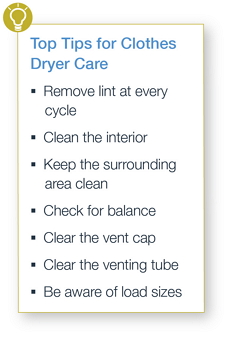Regular
dryer maintenance can minimize fire risks and extend the life of your appliance.
The leading cause of home clothes dryer fires is failure to keep
this appliance clean. Therefore, regular dryer maintenance can help extend the
life and efficiency of your machine and minimize the risk
of fire due to lint build up. Here are seven simple steps for taking care
of your dryer and optimizing safety:
 1. Remove lint from
the lint screen after every cycle.
1. Remove lint from
the lint screen after every cycle.
One of the most effective ways to clean your screen is to take a used fabric
softener sheet and wipe the screen down. It’s also advised to clean your
filter’s chute once per season with a vacuum.
2. Clean the dryer’s
interior.
Even if you clean the lint filter regularly, lint can build up within the
dryer. On a monthly basis, unplug the appliance and clean the inside with warm,
soapy water. If your machine uses a sensor, wipe the interior down with white
vinegar or a stainless-steel cleaner to keep it working well.
3. Clean around your
dryer.
Dirt, lint and moisture can accumulate around and under your dryer. Every few
months, vacuum the area to remove debris.
4. Check the balance
of your dryer.
All appliances work best when set up properly. If your dryer is not level, its
parts will wear out sooner. Adjust the unit’s feet until the machine is
balanced.
5. Clear the area
around the dryer’s vent cap.
Snow, leaves and shrubbery can all restrict air flow to your machine, so remove
any obstacles from the area.
6. Clean the dryer’s
venting tube.
Clean your dryer’s entire venting system, from the inside of the dryer to
the outside vent cap annually. You can hire professional cleaners to do the
job, but it’s possible to do it yourself.
7. Pay attention to
the load size.
To increase dryer efficiency, separate loads into different fabric types.
Different fabrics dry at different rates, and drying like fabrics together can
shorten the overall drying time and save energy. Also, loosen bundles of
clothes before adding them to the dryer. If clothes are tightly bundled, some
will end up damp no matter how long they are in the dryer. Finally, do not dry
large items such as quilts or duvets in the dryer. Even larger dryers do not
have capacity for these items and thus the air can’t circulate properly and the
machine could overheat.
Even with regular dryer maintenance, you may run into issues
with your machine. Most dryers can complete a load of laundry in 45 minutes. If
your dryer is taking significantly longer, it may be a signal that it needs
some extra attention. Other signs of a problem include clothes that are still
wet or damp after one cycle, or the dryer moving or shaking as it operates. If
your dryer exhibits any of these signs, it’s most likely time to call
professional help.
Like
any other appliance, keeping your dryer at peak performance requires regular
care and a quick response to possible issues. The few minutes you take to
maintain your machine could add years to your dryer’s life and prevent
catastrophic events such as fires. Contact a HUB International broker today for more information.